“Does not the spraying of the foliage of the trees protect them to some extent in hot weather?” asked J.B. McLaughlin, rhetorically. He had seen the effects of this practice for mitigating heat when he tried it during the devastating heat wave of more than a century ago, on June 14-17 of 1916: “I have 23 varieties of which only 4 were injured. I sprayed the foliage during the hot spell and only the bark on exposed trunks and limbs was injured on a few trees; the rest were not injured.”
Watering an avocado tree’s canopy for evaporative cooling is not a new idea, and its benefits are undeniable. We could even guess that it works before trying it, as we know how much our own bodies are cooled down by jumping into a pool on a hot summer day.
In 1962 an experiment was conducted to quantify these benefits, in terms of how many degrees the temperature could be reduced. Miller, Turrell, and Austin wrote in “Cooling Avocado Trees by Sprinkling” that “temperature reductions up to 5 and 7 degrees were obtained.”
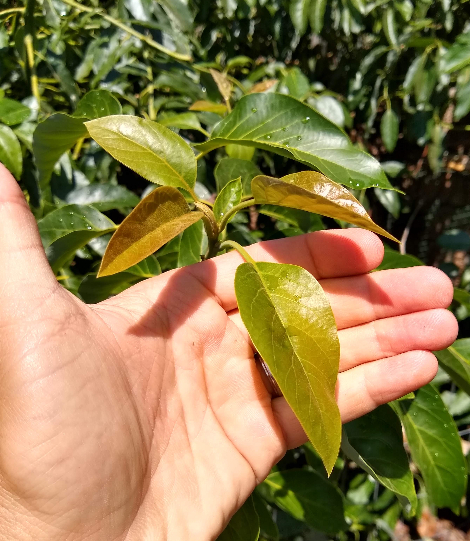
The goal of their experiment was to see if using overhead sprinklers for evaporative cooling could reduce the temperature sufficiently in order to prevent fruit drop from hot weather. Contemporary avocado growers using this method in their commercial orchards have reported that it can indeed totally prevent the loss of fruit during high heat. A commercial avocado grower named Matt Nelson of Temecula employed overhead sprinklers to cool his grove during the heat wave of early September 2020 and reported zero fruit drop while other avocado groves in the area had losses. (See the interview with Nelson in this video by Index Fresh.)
In this post I’ll describe the way some commercial growers like Nelson use overhead watering, but I’ll focus on how home growers can make use of it too. I’ve been trying to achieve evaporative cooling in various ways on my own avocado trees ever since I first encountered the idea in Reuben Hofshi’s paper from 1998 titled, “Dreaming in Reality.” I’ve tried out some new designs in the last few years that I’d like to share.
Four methods of overhead watering
For home growers, the best way to get water all over the canopies of our avocado trees in order to cool them is likely to be through holding a hose in our hands — the simplest method. When I do this, I prefer to use a shut-off valve at the end of the hose so I can adjust the volume, droplet size, and distance that the water sprays.
Farmers can’t walk around with a hose spraying down hundreds of trees though. They mount sprinklers on posts between trees. Some use high volume sprinklers that shoot water far, and because of that they only need a handful of sprinklers to cover an acre of trees.
Others use low volume (micro) sprinklers that only throw water up to about 30 feet so they need more sprinklers by comparison.
I’m a home grower, and most of my avocado trees are arranged in pairs or rows, not blocks. So I’ve had to come up with other ways to use overhead sprinklers efficiently to cool my trees. Over the past couple years, I have been experimenting with two main ways so that I don’t have to run around spraying trees with a hose.
First, if the tree is short, less than approximately 10 feet tall, then I mount a micro-sprinkler on a post within the tree’s canopy. The post might be the same one that served as a training stake when the tree was planted. Here is a Nabal avocado tree with one such setup:
Second, if the tree is taller, then I hang a micro-sprinkler on a branch high up in the canopy. The sprinkler is suspended at a height only a few inches above the highest leaves.
I got this second idea from John Rowley of Nelson Irrigation up in Washington, where such overhead sprinklers are used for cooling apples, pears, and cherries. Rowley made a video showing how to make and hang such a sprinkler, and he shows the video at 2 hours 14 minutes into the presentation here at Index Fresh Seminar 23.
I’ve made a few modifications from Rowley’s design. One is to add a shutoff (adjustment) valve into the line that feeds the overhead sprinkler. This is for two important reasons. I can control the diameter of the sprinkler’s throw, and I can turn the sprinkler off when I’m not using it. This way I can use my overhead sprinklers on the same irrigation lines as my under-tree sprinklers — I don’t have to lay a second set of pipe just for the overhead sprinklers.
Here is what one of my designs looks like before it goes up into a tree:
I am still refining my design and use of these sprinklers hung in large trees as well as those mounted on posts, but I’ve been pleased with their performance in 2020’s September extreme heat as well as in this minor heat wave that just passed last week. Here is a short video showing the two methods in use in my yard:
The micro sprinklers shown in the video are Philmac Challengers. I’ve bought some of these in the past from Grangetto’s. On some of my other trees I use the pressure compensating micro sprinklers made by Jain, which I also find satisfactory, and which come in various outputs and diameter throws, and which I’ve purchased online from Drip Depot. (These are some of the same micro sprinklers that I use for under-tree irrigation, by the way.)
At what temperature to use overhead watering / evaporative cooling?
When do avocado trees need to be cooled? I wrote about this in detail in my post, “Protecting avocado trees from heat.” The short of it is that, in my experience, healthy trees only get damaged when the temperature reaches between 100 and 105.
But in June and early July (late spring and early summer), avocado trees can be carrying very small fruit which is especially susceptible to being shed due to heat stress. Therefore, at this time of year I will run my overhead sprinklers to cool certain trees at around 100 whereas later in summer I don’t bother unless it’s at least 105.
For example, last week on June 15 it reached 102 in my yard so I ran the overhead sprinklers (and sprayed certain trees by hand) throughout the afternoon. (My Reed not only has tiny fruit but is also still blooming!)
In a recent seminar put on by the California Avocado Society, titled “Mitigating Heat,” a few commercial growers mentioned that their temperature thresholds are similar. One grower in Fallbrook said he turns on his overhead sprinklers at about 100 sometimes, and always if it reaches 105. Another grower located in Ojai said he turns his overhead sprinklers on a bit earlier, at between 95 and 100.
How long and often to use overhead watering / evaporative cooling during high heat?
There are two ways one can use overhead sprinklers for evaporative cooling: continuously or in cycles. Some growers simply turn the system on at around 11 AM or noon and run it continuously until the heat subsides at around 4 or 5 PM. This is what I do with my micro-sprinklers mounted on posts or hung in trees.
Alternatively, the trees can be wetted down, allowed to dry, and then wetted again. Repeat the cycle. This is what I do when I spray trees by hand with a hose. I try to hit the trees with water about every 30 minutes, depending on how hot it is.
Growers using overhead sprinklers on cycles generally do runs of around 10 minutes on, where the sprinklers are wetting down the foliage, followed by around 10 minutes off, where the evaporation is happening and the various parts of the tree begin to heat up again. Then the sprinklers come back on to cool them down.
This cycling can save about 50% in water, a big savings if you’re watering hundreds of acres.
In order to run the sprinklers in cycles like this you need the right automatic timer and you also need check valves behind each sprinkler or else you will lose a lot of water to drainage at the low elevations during each off period.
For my situation (not having these requirements) it is more efficient to simply run the overhead sprinklers continuously all afternoon, and it doesn’t use as much water as you might think. For example, on my Hass tree that is about 15 feet tall I have an overhead sprinkler that puts out about 10 gallons per hour. Running that from 11 AM to 4 PM means applying 50 gallons of water. Water in Southern California costs about one cent per gallon so that’s about $0.50.
When you consider that I might have saved dozens — even hundreds — of avocados on that Hass tree from dropping by applying $0.50 in water, it’s unquestionably worth the money.
Conclusion
Cooling your avocado trees by sprinkling them is not the only way of mitigating heat, and it’s not always the best way. Erecting shade is usually the best method for small trees, for example.
Yet for big trees, there is often no option other than evaporative cooling. And by using this method in a timely and well-designed manner, we can get trees through the few days during those occasional extreme waves of heat that have been hitting us since avocados were first grown in California.
All of my Yard Posts are listed HERE

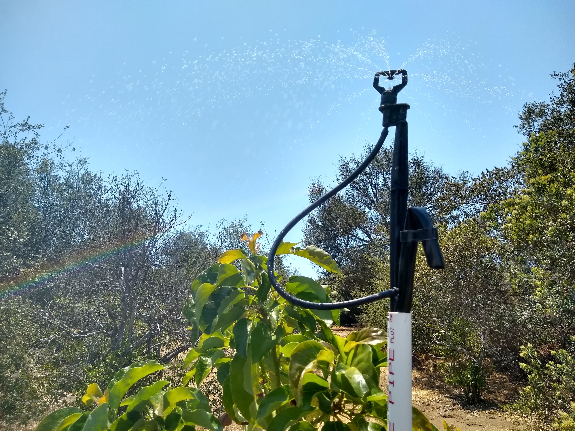

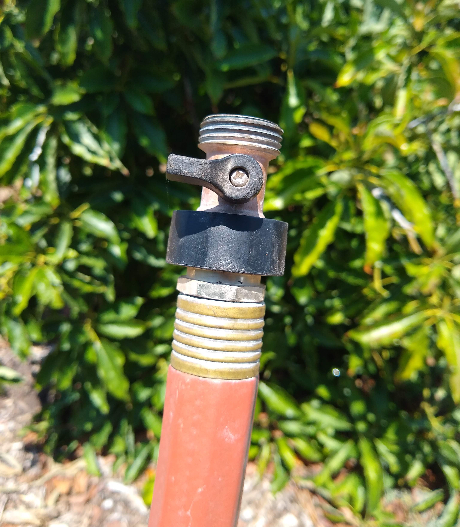
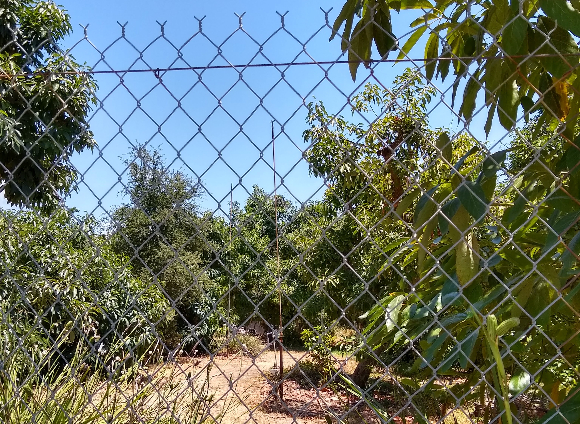
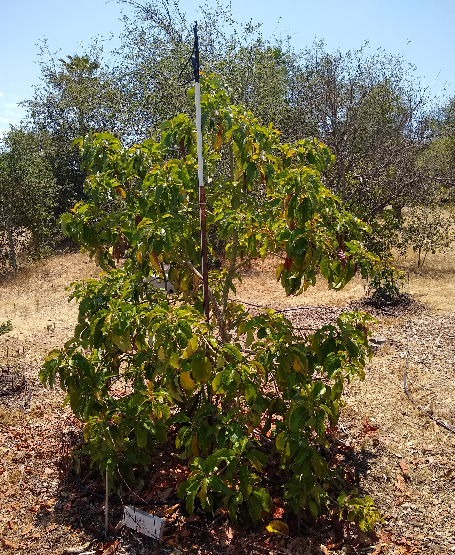


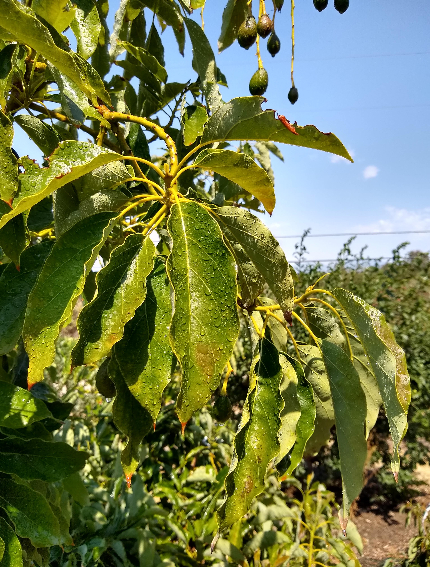
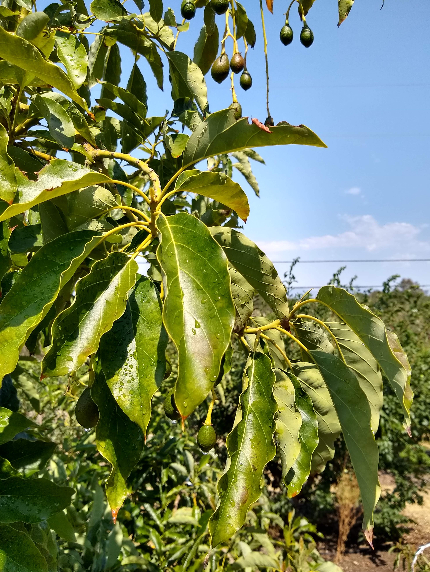



Where do you buy the Nelson Irrigation products, such as the R10T nozzle?
Good question, Karin. According to Nelson’s website, Grangetto’s in Escondido carries them (so maybe other Grangetto’s locations do too).
Grangetto’s website: https://grangettos.com/
Is water pressure an issue? Are 3-4 bar (43.3 – 58.8 psi) that usually comes out of the tap enough for 10-15 sprinklers placed 3m (10ft) above ground level?
Yes, that’s an important concern, Vasco. There are even more factors that influence the performance of the sprinklers including whether they are pressure compensating and how large their orifices are.
But my main discovery has been that you can conserve the most pressure (and therefore run the most sprinklers on one line) by making the tube that runs up the tree large in diameter (e.g. 0.5 inch instead of 0.25 inch) and by keeping it as short as possible.
I’m looking at overhead sprinklers used often in greenhouses, they spray finer mist = less water.
One can span wire rope between two or more posts depending on the distance between the trees and hang both, water pipe and sprinklers on the rope.
This technique is used in the vineyards, not so high in the sky but should work with the avo trees as well.
Just thinking that pumping the water up through one pipe only should reduce the pressure drops.
Sounds right to me, Vasco. I have read about and seen video of farmers doing such a mist or fog effect over apples in Washington. For example, see here: https://youtu.be/R8Jry6x7oUQ
And here: https://jainsusa.com/blog/can-orchard-cooling-improve-fruit-quality-these-2-growers-think-so/
I’d like to try this too.
Just checking in about the heat wave over there in North California. Is it going to affect you as well and how do you intend to handle it?
Crazy temperatures! We heard of more than 46 ºC (115 ºF)!
Hi Vasco,
The West Coast of the U.S. has had a series of heat waves. First we got one down in the south, then central and northern California got one, and most recently, Oregon and Washington got one. Summer started with a bang this year!
Hello Greg,
I’ve heard this method can be used against frosts. Are there any commercial avocado growers in California who uses overhead sprinklers against frost?
Hi Nahit,
Great question. None that I know of. I’ve heard of avocado growers in other countries using overhead sprinklers against frost, but I don’t know details. What I’ve heard from a grower of other types of fruit up in Washington is that you need higher output sprinklers for frost protection compared to for cooling. He said that if you don’t apply enough water through the overhead sprinklers then the ice that forms on the leaves and fruit will not remain at 32 degrees (it will get colder) and you’ll actually cause more damage than if you hadn’t used the sprinklers. I’ve never tried using overhead sprinklers against frost myself.
I just added a overhead mister system and 40% shade cloth for my newly transplanted Carmen from a sleeve, into sandy loam, 3-4″ cedar mulch in inland Oceanside. Still on daily watering, but getting ready to every other day. It is about 3 feet tall and grafted onto an Toro Canyon rootstock. The recent heat caused wilting that seems to have been remedied by the mist and shade. I did notice that yesterday it has started to drop a few leaves that look green and healthy. Could this just been due to the past heat and will they sprout new leaves like citrus does?
Hi Greg. Thanks for the detailed write-up. I finally installed Jain overhead micro sprinklers using your design for my avocado trees in Napa. We generally don’t have as much of an issue with high temperatures as we get cool air coming off the bay; however, the temperature reached 120 in the shade below the trees in Sept 2022 and really set a few of my trees back.
I am using a Rachio irrigation controller and the zone for the overhead cooling is separate from other irrigation zones so I was able to automate everything using IFTTT. So basically an IFTTT applet runs every hour, checks the outside temperature (using Weather Underground and our exact location) and then starts a 25 mins sprinkler run if the temperature is higher than a pre-defined value (still trying to figure out what the right number is considering that the temperature in the sun is easily 10-15 degrees higher than what is being reported by Weather Underground).
Again, thanks for the detailed post on the various evaporation cooling options.
Hi JS,
Sounds like an excellent setup. It’s hard to know when to run the system, but I think it depends partly on what you’re protecting. For example, you’ll want to run it at a lower temperature if you’re protecting young fruit from an early June heat wave compared to a late summer heat wave.
So far this summer I’ve only run my system once on a certain section of trees because I did some grafting and I wanted to keep those trees both cooler and more humid while the grafts were healing. (I shaded the grafts too.)